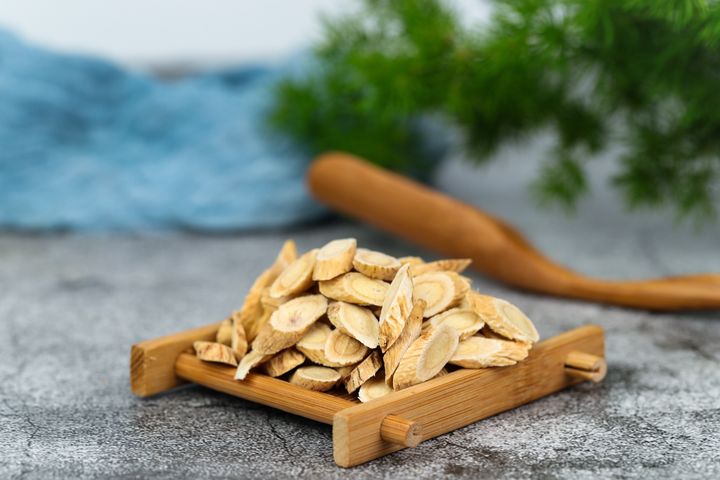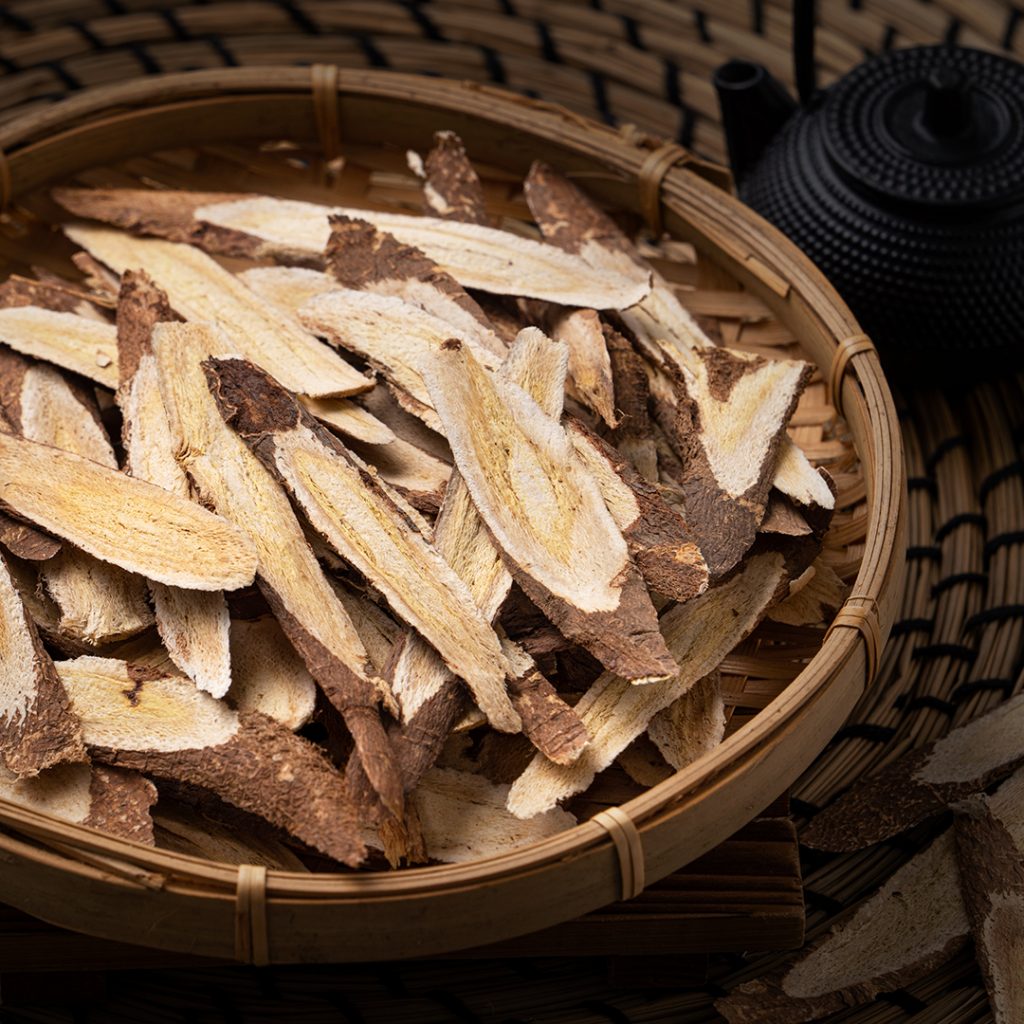Milkvetch Root (Astragalus Root)

What is Milkvetch Root (Astragalus Root)?
Milkvetch Root (huang qi, 黄芪), also known as Astragalus Root, is one of the 50 fundamental herbs in Traditional Chinese Medicine (TCM). It has been used as an essential tonic in TCM for more than 2000 years. It was first indexed in the Compendium of Materia Medica, where it was rated as a Class 1 herb, which means that it is edible and has less or no harm at all to the human body.
Legend says that during ancient times, there was a nice old man whose name was Daishan. He was a master of acupuncture therapy and was always ready to help others in need. His body was thin and his face was yellowish, and thus many called him Huang Qi, which means a yellow elderly man. The man died while he was saving a child falling off a cliff, and a sweet herb grew on his tomb. This herb has the effects of invigorating the spleen, and it was used to cure many patients. In order to commemorate it, people then called the herb huang qi.
In TCM, Astragalus Root belongs to the category of ‘Tonic herbs for Qi Deficiency’. This herb can help to nourish qi, blood, yin and yang, thus it is often used by individuals who are experiencing patterns of Deficiency. Warm in nature, this herb can help individuals who have too much ‘Cold’ in their body, such as those who are experiencing Yin Excess or Yang Deficiency.
Sweet in taste, Astragalus Root helps to slow down acute reactions and detoxify the body. This herb also has a tonic effect on the human body because it replenishes qi and blood. In particular, this herb targets the Lung and the Spleen.

Functions and Benefits of Astragalus Root
Traditional Chinese Medicine (TCM) shows that Astragalus Root have 3 main functions:
Firstly, Astragalus Root can help to relieve the syndrome of Spleen-Lung Qi deficiency. It is a key qi tonic due to its efficiency in tonifying the Spleen and regulating qi. This herb can be combined with other herbs to treat symptoms such as shortness of breath, fatigue, poor appetite, loose stool, bleeding syndromes and blood prostration due to Spleen Deficiency. It is also used to cure thirst as it can tonify qi and increase yang.
Secondly, Astragalus Root can tackle the syndrome of spontaneous sweating caused by Qi Deficiency. By tonifying qi in the Lung and Spleen, this herb can strengthen superficies to regulate sweating. For example, this herb can be combined with sweating-astringing herbs to tackle the insecurity of defensive qi (wei qi, 卫气), exterior Deficiency and spontaneous sweating.
Thirdly, Astragalus Root can be used for Blood Deficiency syndromes as it can supplement blood by tonifying qi and nourishing blood. Hence, it is often used to treat iron deficiency, low blood pressure and low blood sugar.
Fourthly, Astragalus Root is often used for oedema and difficult urination caused by qi Deficiency by inducing diuresis.
Fifthly, Astragalus Root is commended as the most effective herb for sores and ulcers because it can dispel toxins to promote skin generation through tonifying qi and blood.
Other than the above Astragalus Root benefits, modern studies have also found that Astragalus Root may boost your immune system by increasing your body’s production of white blood cells, preventing and fighting bacterial infections such as the common cold.
Also, Astragalus Root may improve your heart function by widening your blood vessels and increasing the amount of blood pumped from your heart. Not only that, it is also suggested that this herb may be able to alleviate the negative side effects of chemotherapy.
The active compounds in Astragalus Root may help to lower blood sugar levels in individuals with Type 2 diabetes too. In fact, it has been identified as the most frequently prescribed herb to help with diabetes management in China.
In addition, Astragalus Root may support kidney health by improving blood flow and kidney function. It may also help to prevent infections in people with reduced kidney function.
Other potential Astragalus benefits include improving symptoms of chronic fatigue and seasonal allergy symptoms.

How to Use Astragalus Root
Astragalus Root can be consumed directly, added to dishes, or made into many different forms of supplements, such as liquid extracts, capsules, powders and herbal teas.
In addition to its extensive medicinal uses, this herb is also one important ingredient in many popular Cantonese soup recipes for the purpose of tonifying. Usually, the recommended dosage is 9 – 30g per serving.
Today, Astragalus Root is also widely accepted by the westerners as a common supplement because it can help sleep and enhance energy and libido.
Not only that, Astragalus is sometimes also given as an injection or by IV drip in a hospital setting.
Cautions and Side Effects of Astragalus Root
Though astragalus is safe for most people, certain groups of people should avoid it. As there is not enough research to demonstrate that Astragalus Root is safe for consumption during pregnancy or breastfeeding, hence we advise that pregnant ladies should avoid consuming Astragalus Root.
Also, as Astragalus Root may increase the activity of your immune system, individuals with autoimmune diseases and individuals who are taking immunosuppressant drugs should avoid this herb too.
If you have diabetes or are experiencing issues with your blood pressure, do also use this herb with caution.
Some common side effects of Astragalus Root include rashes, itching, nausea, headache and fatigue. When given by IV, Astragalus Root may have more serious side effects, such as irregular heartbeat.
Do remember to check in with your healthcare provider if you would like to add Astragalus Root to your diet!
Summary
Here is a summary for Astragalus Root:
- Herb name (Chinese): 黄芪
- Herb name (Pin Yin): huáng qí
- Herb name (English): Milkvetch Root
- Herb name (Botanical): Radix Astragali
- Origin of species: Astragalus membranaceus (Fisch.) Bge. var. mongholicus (Bge.) Hsiao
Astragalus membranaceus (Fisch.) Bge. - Part(s) of herb used: Root
- Geo-specific habitat(s): Inner Mongolia, Shanxi, Heilongjiang
- Taste(s) & Properties: Sweet; Slightly Warm; Administrates the Spleen and Lung meridians
- Actions: Boosts digestive and respiratory functions; Eases symptoms of excessive and uncontrollable perspiration; Promotes drainage of pus to assist in recovery of abscesses difficult to heal.
References
Duffy, C. F., & Power, R. F. (2001). Antioxidant and antimicrobial properties of some Chinese plant extracts. International journal of antimicrobial agents, 17(6), 527-529. [Accessed on 18 September 2022]
Fu, J., Wang, Z., Huang, L., Zheng, S., Wang, D., Chen, S., … & Yang, S. (2014). Review of the botanical characteristics, phytochemistry, and pharmacology of Astragalus membranaceus (Huangqi). Phytotherapy Research, 28(9), 1275-1283.[Accessed on 18 September 2022]
Shahrajabian, M. H., Sun, W., & Cheng, Q. (2019). A review of astragalus species as foodstuffs, dietary supplements, a traditional Chinese medicine and a part of modern pharmaceutical science. Applied Ecology and Environmental Research, 17(6), 13371-13382.[Accessed on 18 September 2022]
Share this article on
